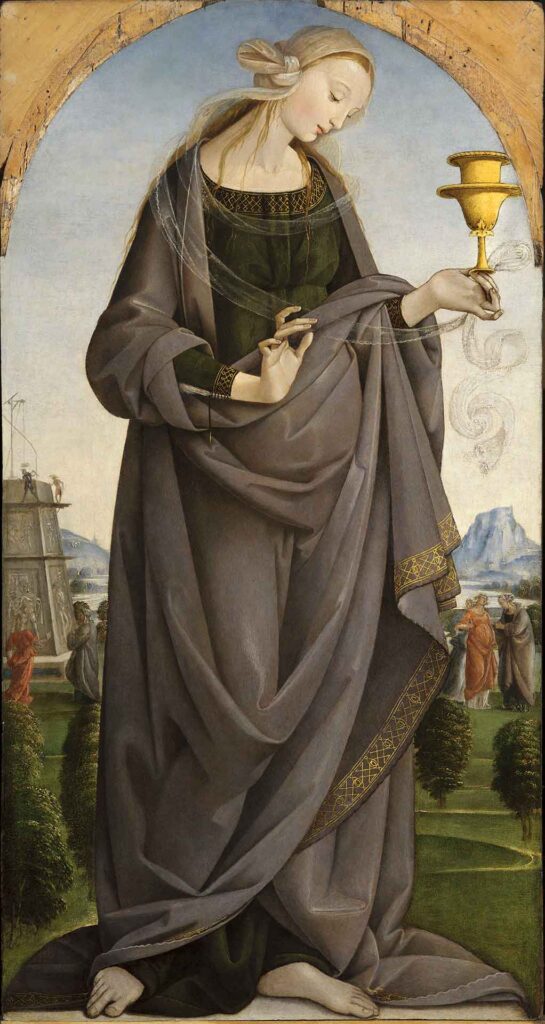Artemisia
Maestro di Griselda , ca. 1498
Description

The panel depicts a heroine of antiquity, Artemisia, who lived in Anatolia in the 4th century b.C. According to Valerius Maximus and Aulius Gellius, she had married her brother Mausolus, satrap of Caria, and after his death she dedicated her life to celebrating his memory, having a monumental tomb erected in his honour. It was the famous Mausoleum of Halicarnassus (the modern Bodrum, Turkey), one of the seven wonders of the ancient world.
Besides, following the legend, she drank Mausolus’s ashes, in order to become his living tomb.
The elegant figure of Artemisia dominates the scene, and the painting’s refinement is evident in the movement of her transparent veil and in the grace of her hand holding the cup. In the background, on the right, Artemisia is about to drink her husband’s ashes mixed with her tears; on the left, she oversees the construction of the Mausoleum.
Set in a sumptuous nineteenth-century neo-Gothic style frame, the panel was part of a series of paintings, of similar size and composition, depicting women and men of antiquity celebrated for their virtues. There are eight panels in all, four with female figures and four with male ones. Possibly the cycle was originally intended to decorate a room in a private residence, and it was made on the occasion of a wedding, as some paintings, like this one, celebrate conjugal love and fidelity.
The work, datable between 1490 and 1500, is attributed the Master of Griselda, a refined and still anonymous painter active in Siena in the late 15th century.
Data Sheet
Author
Master of Griselda
Date
ca. 1498
Material and technique
Tempera on panel
Measures
87.8 cm x 46.3 cm
Acquisition
Gian Giacomo Poldi Pezzoli bequest, 1879
Inventory number
1126
location
Black Room
The Black Room is one of the Museum’s historic rooms, originally the living room of Gian Giacomo Poldi Pezzoli’s apartment. Inspired by the Northern Renaissance style, evoked by the large Flemish polyptych displayed on the wall, it continued to be called Sala Nera despite the destruction of the very fine ebony panelling. Fortunately, the furniture and doors, designed by Giuseppe Bertini and made by the team of artisans Giuseppe Speluzzi, Luigi Barzaghi and Pietro Zaneletti, survived the bombing.
collection
Paintings
The Museum hosts over 300 paintings. Among them, many Italian works from the Renaissance: masterpieces from Tuscany (Botticelli, Piero della Francesca, Pollaiuolo), Lombardy (Luini, Boltraffio, Solario) and Veneto (Bellini, Mantegna). Important is also the group of 18th century Italian painting (Guardi, Canaletto, Tiepolo, Fra Galgario). In the collection, there are mainly portraits and small size paintings.
